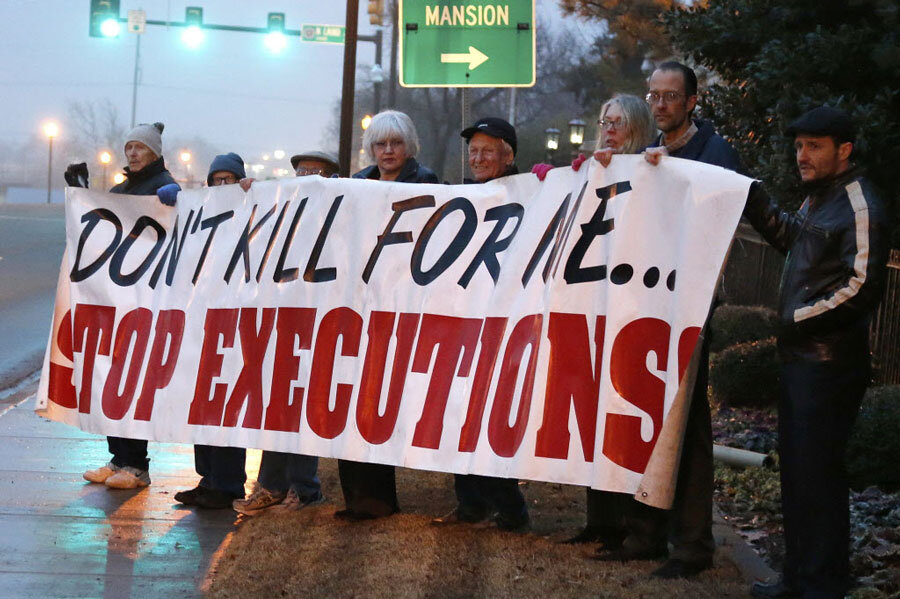This year, US imposed fewest death sentences in four decades
Loading...
The number of executions in the United States continued to decline in 2014, with 35 people put to death, compared with a peak of 98 in 1999 and 39 last year.
There were 72 death sentences imposed this year, the lowest in 40 years and down seven from last year, according to a report released Thursday from the Death Penalty Information Center (DPIC) in Washington.
The decline in the use of the death penalty stems from a combination of factors, including a large drop in violent crime between the late 1980s and early 2000s and the fact that all states with the death penalty now offer the alternative of life in prison without parole.
But various aspects surrounding how the death penalty is imposed have also been troubling to some state leaders in recent years.
“Six states since 2007 have abolished it completely.... They said the death penalty risks innocent lives, the death penalty costs a lot, the death penalty is biased in some cases,” says Richard Dieter, DPIC’s executive director.
Executions in Ohio, Arizona, and Oklahoma generated strong reactions this year because of drawn-out lethal injections that some deemed to be cruel. Such states have resorted to using new lethal injection drug formulas because the traditional providers of the drugs have stopped supplying states.
A federal judge is hearing a challenge by death row inmates in Oklahoma who claim the lethal drug combinations violate the constitutional ban on cruel and unusual punishment.
Dudley Sharp, a Texas-based pro-death-penalty expert and former political director of Justice for All, a criminal justice reform group, agrees the Oklahoma execution was botched, but says that based on his conversations with anesthesiologists, the executions in Arizona and Ohio should not be characterized the same way.
In April, Ohio officials said they would increase the dosage for future executions, although after a review of the execution in question, the Department of Rehabilitation and Correction said it was “confident that it conducted the execution in a humane, constitutional way and that the inmate was completely unconscious and felt no pain.”
A number of states executed inmates this year in cases that were controversial because of mental illness. Recently, a federal judge stayed the execution of Scott Panetti in Texas because of his long history of schizophrenia.
Public opinion on the death penalty is largely split. When asked whether the death penalty or life in prison without the possibility of parole is the better approach for a murder conviction, 50 percent favored the death penalty, 45 percent favored life in prison, and 5 percent had no opinion, according to a Gallup poll in September. In 2001, 54 percent favored the death penalty and 42 percent favored life in prison.
The DPIC report notes:
- Seven states executed at least one inmate in 2014, the fewest number of states in 25 years, though many more maintain death rows.
- Sixty-six percent of those executed this year were members of minority groups. As of October, 57 percent of the 3,035 inmates on death rows were minorities.
- Washington Gov. Jay Inslee (D) announced that no executions would take place while he is governor, joining the governors of Oregon and Colorado in halting executions.
Seven death row inmates were exonerated this year, based on DPIC’s count. Three of them had been convicted in an Ohio case, and two of the defendants in that case were released from prison in November after 39 years. (Previously, the sentences for all three men in that case had been commuted to life imprisonment.)
Mr. Sharp says DPIC pursues an anti-death-penalty agenda by misleading the public to think of those on its list of exonerees as innocent, although the defendants proved innocent through DNA, for instance, are only a portion of those on the list.
On its website, DPIC does have an “Innocence List” but states that the criteria include being acquitted of charges that placed them on death row or having all such charges dismissed by the prosecution, in addition to being pardoned based on evidence of innocence.
The first two categories can include cases in which there were mistakes with evidence, witness problems, or other issues with the original trial that led a judge to later acquit or order a retrial. In some cases, prosecutors may have decided to dismiss charges rather than try a person again.
“We’re not saying we know exactly what happened ... but in our system they are as innocent as anyone else,” because people are presumed innocent if not proven guilty, Mr. Dieter says.
In 2011, the Florida Legislature’s Commission on Capital Cases examined 23 cases of people released from death row for convictions dating back to 1974. It found that 17 percent of the releases were based on doubts about guilt, 39 percent based on issues with evidence, 30 percent on issues with witnesses, and 17 percent on issues with court officials. As of 2006, 10 had been convicted of felonies committed after their release.








